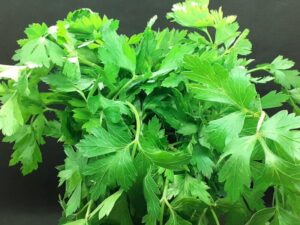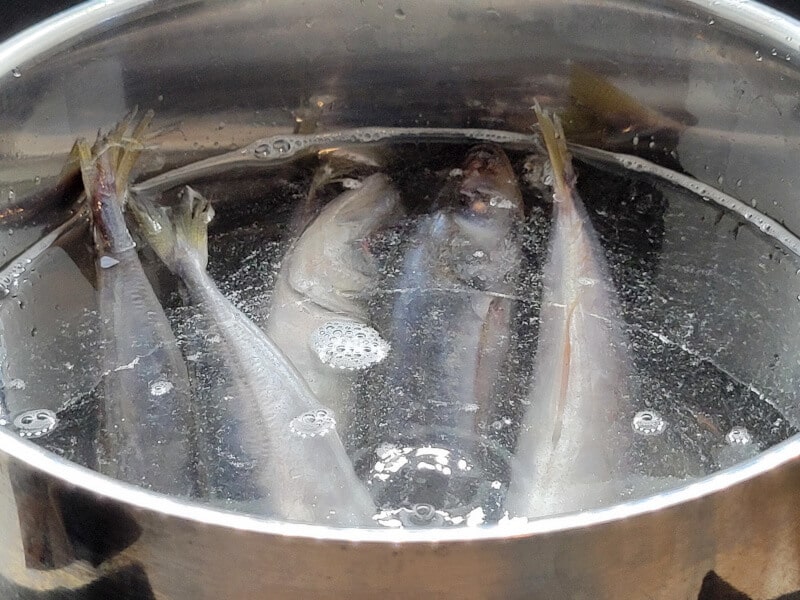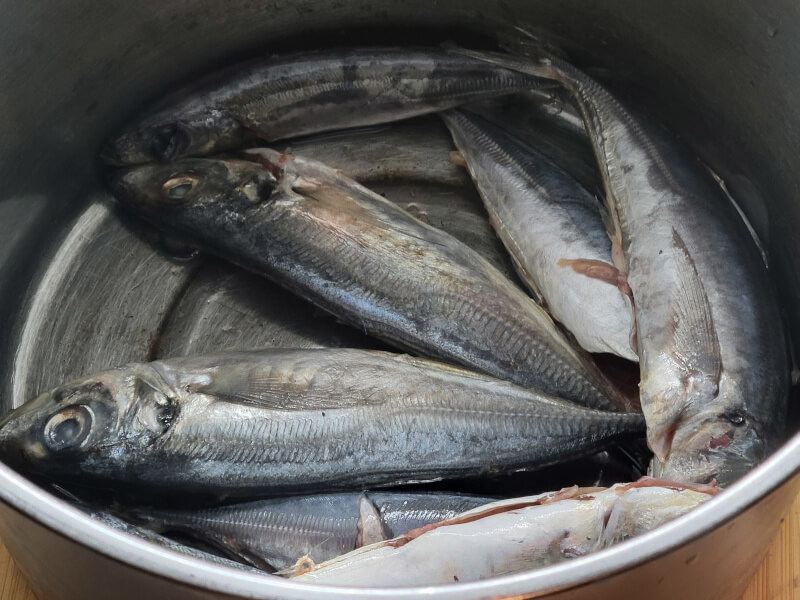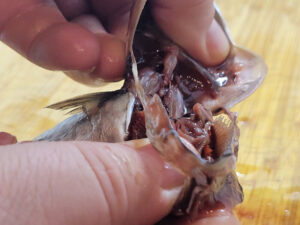Enjoy a traditional Portuguese fish dish! This simple Seafood recipe takes Portuguese Mackerel through a Fish Breading before pan frying in lard or oil for some Crispy Fried Mackerel (Chicharros Fritos or Portuguese Fried Mackerel). Then saturates the mackerel fish Fry with an Oil & Vinegar sauce with Pimento Paste and lots of Garlic, also known as Villain Sauce or Molho Valão. Served with Rice or Potatoes. Optionally with Portuguese Cornbread to sop up the sauce and eat with the Chicharros, a very nice addition to the meal. Make it as Mild, Medium or Spicy as desired with the use of Hot Pimento Paste and/or Hot Paprika or by just adding Chili Flakes until the desired heat is reached.
What is Portuguese Mackerel
Portuguese Mackerel is breaded and pan fried Mackerel served with Molho Vilao or Villain sauce. Which is a Tangy, Savory Sauce with lots of Garlic, that is poued over the Fish and covered to rest before serving. It is usually served with a side of Rice or Potatoes and Corn bread to sop up the sauce, Fries are nice too.

What is Portuguese Mackerel Called
Chicharros: is the Portuguese name for jack mackerel, a species from the genus Trachurus. These fish are quite different from true mackerels (Scomber genus), though they share similar characteristics in terms of their oily flesh and popularity in Mediterranean and Atlantic cuisines.
In Portugal, Chicharros typically refers to the European jack mackerel (Trachurus trachurus), which is also sometimes called blue jack mackerel or horse mackerel in English.
Trachurus: is the scientific genus name for a group of fish commonly known as jack mackerels. There are several species in this genus, but in the context of Portuguese cuisine, the most well-known species are:
- Trachurus trachurus (European jack mackerel, or chicharro)
- Trachurus picturatus (Atlantic horse mackerel)
They are sometimes confused with true mackerel in recipes, especially when it comes to grilled fish dishes like “chicharros fritos” (fried jack mackerels) or “chicharros à lagareiro” (baked with olive oil, garlic, and herbs), but they are technically a different fish.

Portuguese Mackerel Breading
Seasoned Flour is used for an incredible well seasoned breading that crisps up really nice. Traditionally White Cornflour is used and for a Gluten Free version you can stay with using Corn Flour. Although I would still add in the Salt, Pepper and Cayenne from the Seasoned Flour for added taste. Either one is fine and just comes down to preference or what you have on hand.

Portuguese Mackerel Sauce
Molho Valão is a traditional Portuguese sauce typically served with grilled/fried fish, especially mackerel. It also goes by the name of Villain sauce. This is a breifly cooked, bold sauce, with separate flavors, rustic texture, and visual appeal. It’s suppose to be thin so that the fish can absorb the sauce and the sauce can be shared across side dishes that may be served with it and soaked up by corn bread that is really good with this dish.
The ingredients are combined and simmered until the garlic is soft, then it’s poured over Fried or Grilled Fish. Its simplicity enhances the natural flavors of the fish, making it a perfect accompaniment for dishes like Fried Mackerel or Grilled Sardines
The sauce is usually made with a few simple ingredients but is packed with flavor. A typical molho valão is made with:
- Olive Oil: A staple in Portuguese cooking.
- Garlic: Minced or crushed for a strong, aromatic flavor.
- Vinegar: Usually white wine vinegar, providing acidity to balance the oil and enhance the flavors.
- Fresh Herbs: Parsley is common, but sometimes oregano or thyme is used.
- Spices: A pinch of salt, pepper, and sometimes paprika.

Portuguese Mackerel Ingredients
Mackerel, Corn Flour or Seasoned Flour, light tasting Olive Oil/EVOO, White Vinegar, Pimento Paste (Sweet or Hot), Garlic, Smoked Paprika (Good Quality like Hodi Smoked Sweet Paprika with Beech), Leafy Green (Parsley and/or Cilantro),









Type of Fish for Portuguese Mackerel
The type of fish that is used for this Azores Chicharros with Villain Sauce, is traditionally Horse Mackerel, Stickleback Mackerel or Trachurus. A whole bag of approximately 750g is used. Other types of Mackerel can certainly be used.
These typically run for about $5-$7 CAD and is enough for 3-4 servings. I pick mine up at No Frills or a local Portuguese Grocery store.


How to Thaw Frozen Fish
There are two main ways you can defrost frozen fish, depending on how much time you have and when you plan on cooking the fish. No matter how you decide to thaw the fish there are some things to keep in mind, these are;
- Never thaw fish at room temperature, this can allow harmful bacteria to grow.
- Cook fish soon after thawing to ensure freshness. Cook the fish within 1–2 days if thawed in the refrigerator, or immediately if thawed in cold water.
- These methods will help ensure your fish stays safe and delicious!
Refrigerator Thawing (Best Method)
- Place the frozen fish in a dish or tray to catch any liquid.
- Cover the fish or leave it in its packaging to avoid drying out.
- Thaw the fish slowly in the refrigerator for 12–24 hours, depending on the size and thickness.
- This is the safest method, keeping the fish at a consistent, cool temperature.
Cold Water Thawing (Faster Method)
- Seal the fish in a leak-proof plastic bag to prevent water from seeping in.
- Submerge the bag in a bowl of cold water.
- Change the water every 30 minutes to maintain a cold temperature.
- Depending on the thickness, fish will thaw in 30 minutes to 2 hours.
- Cook the fish immediately after thawing with this method.

Direct Cold Water Thawing (Fastest Method)
For these fish I do tend to place them directly in the water to thaw as this method doesn’t really affect the skin so much and they are being breaded and fried so all good. Once they are thawed and gutted, the water will be emptied out and the pot filled again to wash the fish before they go straight to breading. Coating the fish in water before breading also helps for more breading to stick.

Preparing Chicharros
Once the Fish are fully thawed, empty the water out and place the fish directly into the pot and fill with water again. Set aside a bag that you can throw all the fish innards in and tie or seal to throw away so it doesn’t stink up the house.

Place the Mackeral on the cutting Board.

Slice all the way from the bottom jaw to the tail. This allows you to get at the Gills to pull them out.

Pinch behind the gills to pull them out along with everything else to gut the fish. It should all come out in once piece.

Throw them back into the pot of water to rinse them.

Strain out the water and start breading each Fish. A bit of fresh water can be left in the pot to keep the fish wet for better breading.
While you can do each Fish on the cutting board. I typically don’t. Instead, I do this over the sink and don’t use a cutting board at all. This centralizes the mess just over the kitchen sink and it’s pretty quick. Grab each fish from the pot of water, slice at the bottom jaw and all the down to the tail, pull the innards out from the gills. Back into the pot of water it goes and repeat for the next one. It really is a very efficient way to gut fish.






Portuguese Mackerel Breading
Traditionally, these are prepared by dusting them in just Corn Flour. However, I find that the Seasoned Flour breading works so wonderfully here and use this instead. On the other hand, if you’re looking for a gluten-free Portuguese Mackerel dish, then stick with the 1 Cup of White Cornflour. But I would still add in the seasoning from the seasoned flour for better flavor.
Seasoned Flour is a well versatile all-purpose seasoning flour that can be used in numerous places, and it does an excellent job here with fried fish. I commonly use this for Seafood, as the Barley flour in it seems to work wonders with Seafood, and it also includes the original Corn Flour.
Bread the Fish Fillets in this seasoned flour with the basic seasoning included in the recipe before frying.

How to bread Portuguese mackerel
Bread the Fish in seasoned flour or cornflour. Both inside and outside, pressing the breading in and shake before placing them on a wired rack to await being pan fried. Repeat for each Fish. If the fish is to dry for the berading to stick, wet it with water before breading. Allow the Fish to rest while heating the pan of oil up. This gives time for the breading to hydrate a bit and creates a better coating for frying.
You can also double coat these for even more breading that results in a crispier exterior. Ensure that the Fish have a good breading on them that will adhere and stay intact while frying. If it is just dusted, it will wash off, when the fish goes into the hot oil and that’s just no beuno.

Portuguese Fish Sauce
The Portuguese Mackerel/Chicharros sauce also known as Villain Sauce or Molho Valão, is made up of Oil, Vinegar, Garlic, Pimento Paste, Paprika and Parlsey and/or Cilantro. It’s like a Chimichurri Sauce, but instead of a 3:1 ratio of Oil to Vinegar, we up the Acidity to a 1:1 ratio. Which yields a tangy sauce with bold garlic flavors and a bit of heat.
This sauce has a strong acidity to it, which can be reduced or increased based on preference. However, it is the acidity that makes the entire dish pop. It really is a delicious Portuguese Seafood Dish.
How to make Villain Sauce
To make Portuguese Chicharos Fritos Sauce, Molho Valão or Villain Sauce;
- Add Oil into the pan over medium heat and add a whole head of thinly sliced garlic. Cook while stirring but do not brown the garlic.
- Once the garlic is just softened, add in the remaining ingredients to mix through, simmer on low until the garlic is completely soft, about 5 minutes.
- Remove from heat and pour over the Crispy Fried Mackerel inside a casserole or Grilled Sardines.

Emulsified Sauce
I originally thought of this sauce as a vinaigrette and it occured to me that this should be emulsified. I mean if the only reason you were cooking the sauce was to soften the garlic, then could you make this vinaigrette style where the whole thing is emulsified. Wouldn’t this improve the garlic flavor. Yeah, No, Don’t emulsify it, it doesn’t work and here’s why.
Why Molho Valão is not a vinaigrette
Overall you just get better and spearate flavors when it is not emulsified. So yes, although it does appear to be a vinaigrette, it’s definately not. Emulsifying changes the fundamental qualities of a traditional Molho Vilao. That being bold, separate flavors, rustic texture, and visual appeal. Very similar to a Chimichurri for those same exact qualities.
The emulsified sauce will be to thick for the fish to absorb. While you do get better garlic flavor throughout the sauce, part of the pleasantries in eating this is the thinly sliced garlic that has been softened.
Additionally that sauce is used not only over the fish but your sides like rice or potatoes, so you want a thin sauce where it can easily be consumed with the side of choice. Also to be sopped up by cornbread which is an excellent addition. There is also more tang since the vinegar is not binded and individual flavors can be tasted through the entire dish.
As a side note, the sauce goes to an organge color because of the incorporated air, instead of staying red like a traditional Portuguese dish. Although I am thinking, okay not for Chicharros Fritos, but a Portuguese Salad?
Maybe that will come sometime in the future. But for this dish, No Bueno.
That Fried Fish looks good though! That’s with the Seasoned Flour, really crispy with good flavors. Just Amazing!

Portuguese Mackeral Sauce addins
Other ingredients can certainly be added to shape the flavors as you desire. Some common additions are Cinnamon, Cumin, Saffron, Allspice, Tomato Paste, Beer or Wine. Even the white vinegar can be diluted with water for a weaker acid or white wine vinegar used. Parsley is typically used, but this can be exchanged with fresh or dried Cilantro or half each of Parsley & Cilantro. Bay Leaf can be added and Tarragon, which is also a nice addition for the greens added.
No matter what you may add, keep the sauce thin for pouring over the fish.
Heat Level
There is suppose to be some heat in the sauce that can come from either using Hot Pimento Paste or Hot Paprika. Even a bit of Chili Flakes added in. I typically have Sweet Pimento Paste on hand, so use Chili Flakes to add the heat. The Sweet Pimento Paste can be replaced with Hot Pimento paste for a mild to medium heat, with Chili Flakes added to bolster the heat up to that of what you prefer. It is preferrable to use Hot Pimento paste with this recipe.

Frying Oil
The Portuguese choice of Fat or the Fat commonly used to fry fish is lard, well at least in older more rustic Portuguese cooking styles. Extra Virgin Olive Oil has become more common in modern Portuguese kitchens. A Neutral oil can be used just the same.




Olive Oil vs Lard
- Olive oil is often seen as the healthier option today, especially with the focus on Mediterranean diets and its well-known heart-healthy benefits. It also has a lighter, fruitier flavor, which works well for many dishes.
- Lard, on the other hand, is richer and more indulgent, with a heavier, more robust taste. It creates a different texture and flavor profile that’s considered more traditional, especially for dishes like fried fish.
While lard was the go-to fat for frying in many Portuguese homes, especially for chicharros, olive oil has gained prominence in recent decades due to its health benefits and widespread availability. However, in traditional recipes, especially in rural areas or in family kitchens that stick to older methods, lard is still preferred for its authenticity and flavor.
How to Pan Fry Fish
Pan Frying Fish only requires a small amount of fat heated over medium heat. Usually enough to cover the bottom of the pan generously. With Portuguese Mackerel, a little more is added to sort of deep-fry the fish over medium to medium high heat. We’re still frying it in the pan, but with a bit more oil and for a much longer time than you typically would. The objective is to really cook up the fish crisp, like overdone fish.
Heat the Pan up over medium-high heat with the Fat. Use a Thermometer to better gauage the heat. Wait until it hits 375F and fry the Fish in batches until really crisp, about 8 minutes or 4-5 minutes per side. keep moving or flipping them over for even browning. You can’t really overcook these. In fact some will cook them until really tough and crisp like Jerky, which does help them to soak up more sauce. Transfer them to a casserole to await the Villain Sauce that gets poured over top.

Resting
Once the fish are fried up, transfer them to a casserole to await the Sauce. Pour the sauce over the mackerel and cover the casserole to keep things warm and leave to rest for 10 minutes or longer. The longer it rests, the more flavor it absorbs. It is recommended to let rest 1 hour before reheating again prior to serving. I don’t typically do this and just rest for about 20 minutes.
This is also the perfect time to start any sides like Boiled or Steamed Potatoes, Rice or Fries.
Although this dish can be prepared a head of time with the Fish & Sauce sitting in the casserole and covered. Then reheated in the oven before serving.
How to Eat Portuguese Mackerel
It’s simple enough just gently use a fork to loosen the meat from the bones, or use your fingers to carefully pull the meat away from the spine. Start from the top (near the head) and work your way down.
Some will eat the Mackerel with the bones (extremely beneficial for bone health) and others will even eat the entire fish with the head. With the Gills pulled out and the fish breaded inside and out, the head will be extra crispy. I know it sounds gross, but it really isn’t all that bad, a challenge I suppose.
Portuguese Mackerel Side dishes
There are a few options for side dishes, such as Rice, Potatoes or Fries, and Salads. A really nice addition is Portuguese Corn Bread that is used to sop up the leftover sauce, ensuring that the plate is completely cleaned off. That’s how ya know its good, just saying. Pop the corn bread in the oven for a bit to warm up and soften, slice and butter to serve.
Portuguese Mackerel with Rice
One such Rice dish I really love, and it brings its own tang and flavors too, is the Chourico Rice Bake. Since the Fish is done stove top, we prepare the rice dish first and finish it in the oven, while the fish is being prepared and cooked, just perfect. Other Portuguese Rice dishes can be used too, typically with Chourico Sausages added.


Portuguese Mackerel with Potatoes
There are many types of potato dishes you can add as a side. From Mashed Potatoes, Steamed Potatoes, Broiled Potatoes and even just some crispy Fries fried in the same oil or Oven Fries. A favorite that delivers on extra garlicky goodness is Steamed Potatoes tossed in Garlic Butter or just toss the potatoes in the sauce and add Salt & Pepper. Another one is just Steamed or Boiled Potatoes with Balsalmic Vinegar, Butter, Salt & Pepper.

Equipment
- 1 Large Skillet
- 1 Pot Fitted with a fine sieve for straining out the oil
- 2 Bowls For defrosting & breading the Fish
- 1 Casserole with cover or tin foil to rest the fish
- 1 Tray with wire rack
- 1 Tong
Ingredients
- 7-8 Whole Blue Jack Mackerel - 750g package, optionally thawed the night before in the fridge
- 1 Portion Seasoned Flour - See notes
Villain Sauce
- 1 C Olive Oil & White Vinegar - each, Vinegar can be added in slightly more amounts
- 1/2 C Hot Pimento Paste - See notes
- 1 Tbl Smoked Paprika - Good Quality
- 1 Head Garlic - Thinly sliced
- 1 Handful Fresh Parsley - can do Cilantro or both
- 1 tsp Sea Salt - or more, taste and adjust
- 1/2 tsp Black Pepper - or more, taste and adjust
Instructions
- Place the Frozen Fish into a bowl and fill with cold water, if not thawed the night before. It will take about 1 hour to thaw through. Meanwhile, prepare the Seasoned Flour and set aside. When the fish is completely thawed, gut the fish, wash and rinse the fish well a few times and strain out the water.
- Heat a deep skillet up over medium high heat with enough fat to almost cover the fish. Fit it with a thermometer so you can gauge the heat with better control. You want about 375F when the fish hit the pan, and stay around 350F — 375F.While that heats up, bread each fish on the inside and outside, shake before placing on a wired rack to await being fried.
- Fry the fish up in 2 batches until really crispy and brown. About 4–5 minutes per side, move them around and flip for even crisping and browning. Transfer the fish to a casserole. When finished frying the fish, empty the Oil into a pot fitted with a fine sieve and return the skillet to the heat.
- Add the Olive Oil with Garlic and fry to soften a bit, but no browning. Add the Pimento Paste & Paprika, mix well. Follow with the Vinegar and lower the heat to low. Cook until the Garlic has fully softened, about 5 minutes or so. Add a handful of Parsley, then empty the sauce over the Fish in the casserole, cover and let rest for 15–20 minutes or longer before serving.

